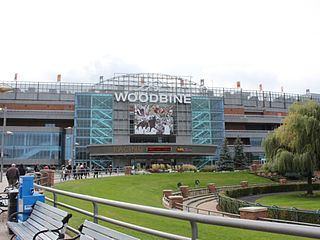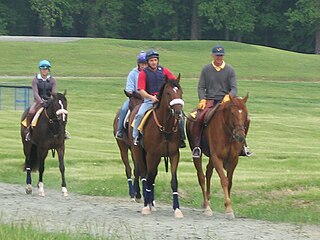Synthetic surfaces
Synthetic surfaces allow racing to take place in bad weather conditions, when it may otherwise be cancelled, and for this reason are sometimes referred to as All Weather surfaces. Manufacturers of synthetic racetrack surface materials promote the fact that synthetic tracks have drainage attributes that are better than natural surfaces. [3]
There is also evidence that synthetic surfaces are significantly safer than dirt in terms of equine breakdowns, though there are many variables that come into play. [4] The statistics for North America in 2015 showed 1.18 fatalities per 1,000 starts on synthetic surfaces, 1.22 on grass courses, and 1.78 on dirt tracks. The breakdown rates were down for each of the surfaces compared to 2014. [5]
The first synthetic surface used for thoroughbred racing was Tropical Park's Tartan turf, a synthetic surface similar to Astroturf installed in 1966. Tartan turf was never a success with horsemen. [6]
The first synthetic surface to replace dirt in the United States was installed at The Meadows Racetrack and Casino in Washington, Pennsylvania in 1963. This surface, called Tartan, was found to be unsatisfactory and removed and replaced with a traditional limestone surface in 1975.
| Name | Manufacturer | Country | Description | Installations |
|---|---|---|---|---|
| Cushion Track | Equestrian Surfaces | | Sand, synthetic fibers, elastic fiber coated with wax. The footing is approximately seven inches deep, followed by a geotextile membrane/tarmac. [7] | Santa Anita Park (replaced)
|
| Fibresand | Mansfield Sand Company | | Sand particles and polypropylene fibres. [8] | Southwell [9] (until 2021) [10] |
| Polytrack | Martin Collins Enterprises | | A mixture of silica sand, recycled synthetic fibers (carpet & spandex) and recycled rubber/pvc. In cold climates, the mixture may also include jelly cable (plastic insulation from copper phone wire). The entire mixture is coated with wax. | Lingfield Park Kempton Park Chelmsford City Dundalk Chantilly Marseille-Vivaux Pau (CLOPF) Kranji, Mijas(CLOPF) Veliefendi Arlington Park Del Mar Racetrack (replaced) Keeneland Race Course (replaced) Pakenham Racecourse, VIC Cagnes Sur Mer Racecourse Deauville-La Touques Racecourse Gokdere & Bedew Racecourses in Ashgabat, Turkmenistan Fairview Racecourse Greyville, Durban South Africa Cambridge and Riccarton Park Racecourse, New Zealand [11] |
| Pro-Ride | Pro-Ride Racing Australia Pty Ltd | | 6 inches of footing (sand, nylon fibres, Spandex fibres coated in a polymeric binder) on top of a 4-inch IMC layer (sand & nylon fibres) on top of a drainage system. [12] | Flemington Santa Anita (removed) Rosehill Racecourse, NSW Warwick Farm Racecourse, NSW [13] |
| Tapeta | Michael Dickinson, Inc. | | Sand, fibre, rubber and wax makes up the top 4-7 inches of the racing surface, installed on top of either porous asphalt or a geotextile membrane. [14] | Spreyton Golden Gate Fields Albany, California Berkeley, CA Presque Isle Downs Wolverhampton Newcastle Woodbine Dubai Racecourse Meydan Turfway Park Gulfstream Park Southwell (from 2021) [10] |
| Visco-Ride | | Sand and fibre coated in wax | Flemington, Victoria (removed) Cranbourne Racecourse, Victoria (removed) Warwick Farm Racecourse, New South Wales (removed) Lyon La Soie (France) Pornichet (France) | |
| EquiPolitrek | Visteks Ltd | | A mixture of silica sand, recycled synthetic fibers (carpet & spandex) and chopped geotextile. The surface keeps the exploitation characteristics in a wide temperature range (from -40° up to +100° С). The entire mixture is coated with wax. [15] | Akbuzat Race Track (First in 2007, Renewed in 2021) International Equestrian Complex, Kazan (First in 2005, Renewed in 2020) International Equestrian Complex, Pradar Equestrian Complex, Jump Equestrian Complex, Nimb Equestrian Complex, Sady Pridoniya |
- ↑Toowoomba has converted 1/2 the synthetic track into turf and have the all-weather track as a training track









